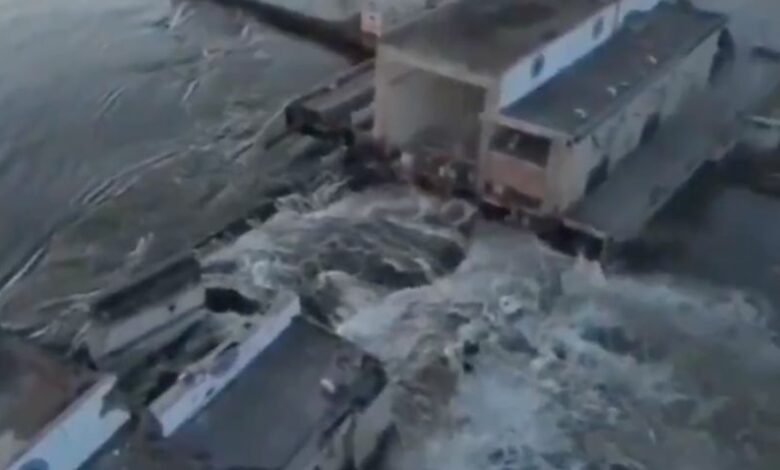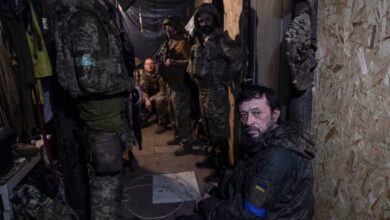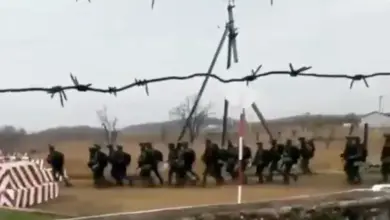
Residents downstream from the Nova Kakhovka dam on the Dnipro River in Kherson were told to “do everything you can to save your life,” according to the head of Ukraine’s Kherson region military administration, as video showed a deluge of water gushing from a huge breach in the dam.
Two videos posted to social media and geolocated by CNN showed the destroyed dam wall and fast-moving torrents of water flowing out into the river. Multiple buildings at the entrance to the dam were also heavily damaged.
The critical Nova Kakhovka dam spans the Dnipro River, a major waterway running through southeastern Ukraine and there are multiple towns and cities downstream, including Kherson, a city of some 300,000 people before Moscow’s invasion of its neighbor.
Multiple senior Ukrainian officials and military figures accused Russia of sabotaging the dam.
Ukrainian President Volodymyr Zelensky, who convened an emergency meeting of his security chiefs, said its destruction “only confirms for the whole world” that Russian forces “must be expelled from every corner of Ukrainian land.”
“This is ecocide,” added Andriy Yermak, the head of the Office of the President of Ukraine.
“The Russians will be responsible for the possible deprivation of drinking water for people in the south of Kherson region and in Crimea, the possible destruction of some settlements and the biosphere,” he said.
European Council President Charles Michel also appeared to blame Moscow, writing on Twitter that “Russia and its proxies” will be held accountable.
“Shocked by the unprecedented attack of the Nova Kakhovka dam,” he said, adding the attack on “clearly qualifies as a war crime.”
‘Save your life’
In recent days Ukraine’s forces have increasingly taken the fight to Russia’s entrenched frontlines in the south and east ahead of a widely expected summer counter-offensive.
Mykhailo Podolyak, a senior aide to Zelensky, said the dam’s destruction would “create obstacles for the offensive actions of the Ukrainian Armed Forces.”
“This once again confirms that the Kremlin is not thinking strategically, but rather in terms of short-term situational advantages. But the consequences are already catastrophic,” he told CNN.
Ukraine’s military accused Russia’s forces of blowing up the dam “in panic”.
Ukrainian authorities urged residents living downstream to escape the area, with about 80 settlements in the zone of potential flooding, according to the Ministry of Internal Affairs of Ukraine.
As of 10:00 a.m. local time, 742 people have been evacuated from the Kherson region, the ministry said.
“We are helping citizens in the liberated west-bank part of the Kherson region. We are worried about our people who remained in the temporarily occupied east bank part of the region,” said Internal Affairs Minister Ihor Klymenko.
Evacuations were disrupted as water began to inundate some settlements, the ministry said.
“Water is coming. The situation is complicated by the fact that some roads are being washed away. This makes it impossible to drive to some settlements. Evacuation teams are looking for other ways,” it continued.
Around 16,000 people on the west bank of Kherson region are in a “critical zone,” Oleksandr Prokudin, the Ukraine-appointed head of the Kherson region military administration, said.
He had previously urged citizens to “collect your documents and most needed belongings and wait for evacuation buses.”
“I ask you to do everything you can to save your life. Leave the dangerous areas immediately,” he added.
Units of Ukraine’s National Police and the state emergency service of the Kherson region have been put on alert to warn and evacuate civilians from potential flood zones, Ukraine’s Ministry of Internal Affairs said.
With the water level rising, authorities urged everyone in the flood zone to turn off all electrical appliances, take documents and essentials, take care of loved ones and pets, and follow the instructions of rescuers and police.
In contrast, regional Russian officials were less urgent in their statements.
The Russian-installed mayor of Nova Kakhovka, Vladimir Leontiev, initially denied the dam had collapsed in an interview with Russian state media RIA Novosti, calling it “nonsense.”
He later confirmed the destruction of parts of the dam in what he called “a serious terrorist act” but said there was “no need to evacuate.”
“Overnight strikes on the Kakhovka hydroelectric power plant destroyed gate valves, causing water to be spilled downstream uncontrollably,” Leontiev said.
Andrey Alekseenko, another Russian-installed Kherson official, also played down the threat saying the situation along the banks of Dnipro was “under control.”
“There is no threat to people’s lives,” Alekseenko said, adding that Ministry of Emergency Situation staff are in control of water levels in the river.
“If necessary, we are ready to evacuate the residents of embankment villages, buses are prepared,” Alekseenko added.
CNN was not immediately able to verify the claims made by Ukrainian and Russian officials.
‘No immediate nuclear safety risk’
Throughout the course of the war in Ukraine both Moscow and Kyiv have accused each other of plotting to blow up the Soviet-era dam.
A critical piece of infrastructure, the dam holds back around 18 cubic kilometers in the Kakhovka Reservoir, about equal to the Great Salt Lake in the US state of Utah, according to Reuters news agency.
The 30-meter-high, 3.2-kilometer (2 miles)-long structure is one of six dams along the Dnipro and supplies water for much of southeastern Ukraine and the Crimean peninsula which was annexed by Russia in 2014.
It also supplies water for the Zaporizhzhia nuclear plant, which lies upstream and is also under Russian control.
On Tuesday, a spokeswoman for Ukraine’s southern command said the dam’s destruction will “certainly” affect the operation of the nuclear power plant but there was “no need to escalate the situation now and draw the most critical conclusions.”
“Because all experts are involved and will try to create better conditions to avoid the next technogenic catastrophe,” said Natalia Humeniuk, adding that “the situation is currently under control.”
And the International Atomic Energy agency said “no immediate nuclear safety risk” exists at the Zaporizhzhia plant and their experts are “closely monitoring the situation.”
Ukraine’s nuclear agency Energoatom said that while water from the reservoir is needed for the “replenishment for turbine condensers and safety systems” of the plant, the cooling pond is “full” and as of 8:00 a.m. local time “the water level is 16.6 meters, which is sufficient for the plant’s needs.”
In November, the Nova Kakhovka dam was damaged in shelling and satellite images from Maxar Technologies obtained by CNN showed water flowing out of three sluice gates at the dam.
CNN’s Sophie Jeong, Sarita Harilela, Seb Shukla and Victoria Butenko contributed reporting.




